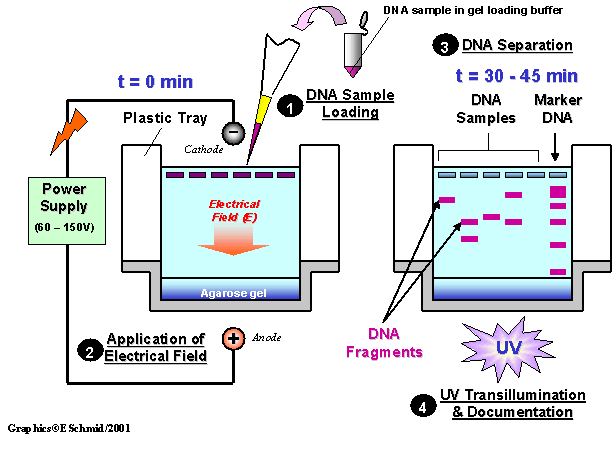Gel Electrophoresis
Key Questions
-
Answer:
Gel electrophoresis is the process by which we take the DNA and run an electric charge through it, therefore we can use it to compare two DNA samples, hence the name DNA fingerprinting.
Explanation:
Gel electrophoresis is basically the process by which we take the DNA, and run an electric charge through it. The DNA, being negatively charged by default, will move towards the positive side. As this happens, he DNA with lower density will travel less distance up. This can create a very unique pattern of DNA.
Now you can do this to another sample of DNA, and match it up with the frequencies of the known sample. If they are the same, then they most likely came from the same source. This is called DNA fingerprinting. This is mostly used in crime investigation, where DNA found at crime scenes is compared to DNA from suspects.
Hope that helped :)
-
The gel doesn't, you add a dye to the DNA sample before putting it in and some dye can be seen under UV light after the gel has been treated with a chemical that activate the dye (ex: ethydium bromide)
-
Answer:
Gel electrophoresis is a biotechnique used to separate DNA fragments and other macromolecules, such as RNA and proteins based on their size and charge.
Explanation:
The molecules to be separated are pushed by an electrical field through a gel containing small pores. The molecules travel through these pores in the gel at a speed which is inversely related. This means that a small molecule will travel a greater distance through the gel than will a larger molecule. One end of the gel has a positive charge and the other end has a negative charge.
Structurally, DNA and RNA are negatively charged molecules, so they will be pulled toward the positively charged end of the gel. In the case of proteins, they are not purely negatively charged, so first proteins are mix with an anionic detergent called sodium dodecyl sulfate. This treatment makes the proteins unfold into a linear shape and coats them with a negative charge, which allows them to migrate toward the positive end of the gel and be separated.
Steps of gel electrophoresis:

When DNA, RNA and protein molecules have been separated using gel electrophoresis, bands of different sizes can be detected by UV illuminator.